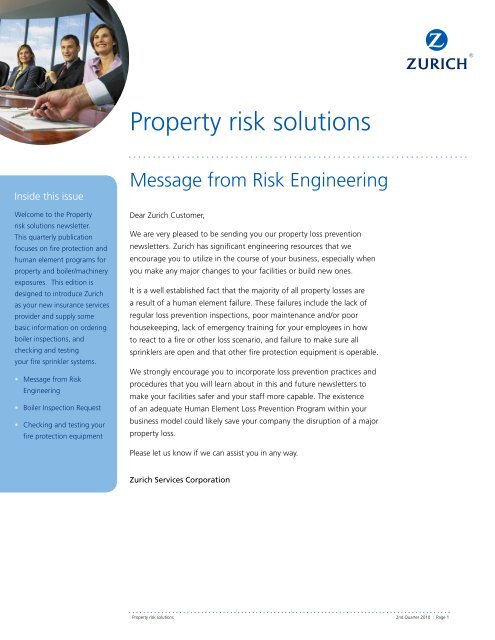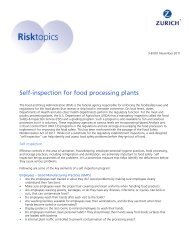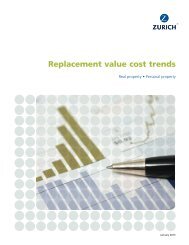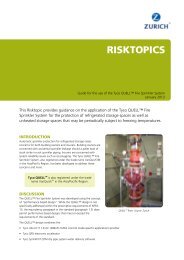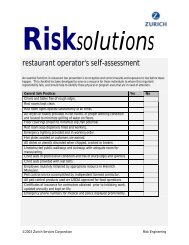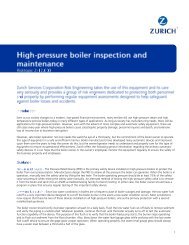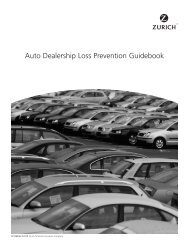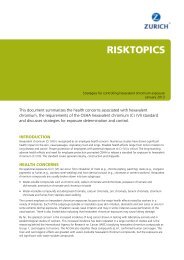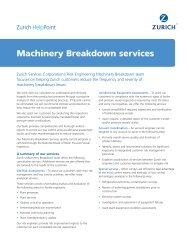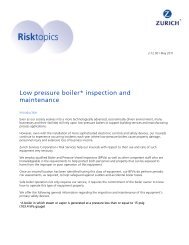Property risk solutions - Risk Engineering
Property risk solutions - Risk Engineering
Property risk solutions - Risk Engineering
You also want an ePaper? Increase the reach of your titles
YUMPU automatically turns print PDFs into web optimized ePapers that Google loves.
<strong>Property</strong> <strong>risk</strong> <strong>solutions</strong><br />
Inside this issue<br />
Welcome to the <strong>Property</strong><br />
<strong>risk</strong> <strong>solutions</strong> newsletter.<br />
This quarterly publication<br />
focuses on fire protection and<br />
human element programs for<br />
property and boiler/machinery<br />
exposures. This edition is<br />
designed to introduce Zurich<br />
as your new insurance services<br />
provider and supply some<br />
basic information on ordering<br />
boiler inspections, and<br />
checking and testing<br />
your fire sprinkler systems.<br />
• Message from <strong>Risk</strong><br />
<strong>Engineering</strong><br />
• Boiler Inspection Request<br />
• Checking and testing your<br />
fire protection equipment<br />
Message from <strong>Risk</strong> <strong>Engineering</strong><br />
Dear Zurich Customer,<br />
We are very pleased to be sending you our property loss prevention<br />
newsletters. Zurich has significant engineering resources that we<br />
encourage you to utilize in the course of your business, especially when<br />
you make any major changes to your facilities or build new ones.<br />
It is a well established fact that the majority of all property losses are<br />
a result of a human element failure. These failures include the lack of<br />
regular loss prevention inspections, poor maintenance and/or poor<br />
housekeeping, lack of emergency training for your employees in how<br />
to react to a fire or other loss scenario, and failure to make sure all<br />
sprinklers are open and that other fire protection equipment is operable.<br />
We strongly encourage you to incorporate loss prevention practices and<br />
procedures that you will learn about in this and future newsletters to<br />
make your facilities safer and your staff more capable. The existence<br />
of an adequate Human Element Loss Prevention Program within your<br />
business model could likely save your company the disruption of a major<br />
property loss.<br />
Please let us know if we can assist you in any way.<br />
Zurich Services Corporation<br />
<strong>Property</strong> <strong>risk</strong> <strong>solutions</strong> 2nd Quarter 2010 | Page 1
Boiler Inspection Request<br />
“A comprehensive<br />
boiler and machinery<br />
maintenance<br />
program can<br />
actually increase<br />
profitability...”<br />
You may have seen the ads on<br />
TV or in magazines for one<br />
of those auto quick lube<br />
retailers in your area. They<br />
all seem to have a similar<br />
message… “Pay now or<br />
pay later!” Although many<br />
of these ads are somewhat<br />
humorous, there is a lot of<br />
truth to what they are saying. A<br />
comprehensive boiler and machinery<br />
maintenance program can actually<br />
increase profitability by improving equipment<br />
life and reliability, and limiting potential for<br />
production losses due to unplanned down time.<br />
In addition, almost all states and many local<br />
communities have regulatory requirements that<br />
make business owners responsible for the regular<br />
inspection of boilers and pressure vessels.<br />
Zurich Services Corporation <strong>Risk</strong> <strong>Engineering</strong><br />
understands that machinery breakdown<br />
assessments and jurisdictional boiler/machinery<br />
inspections are critical elements of any facility’s<br />
comprehensive maintenance program. Zurich<br />
can provide jurisdictional inspections to meet the<br />
inspection and reporting requirements of various<br />
states that have adopted the American Society<br />
of Mechanical Engineers (ASME) Boiler and<br />
Pressure Vessel Code.<br />
You may request a boiler inspection online or by<br />
calling Zurich’s toll free number.<br />
• Online request – Go to http://www.<br />
zurichna.com/. Click on Online Services/<br />
Customers/Boiler Request form.<br />
• Phone requests – Call us during the hours of<br />
8:00 a.m. - 5:30 p.m. CST Monday through<br />
Friday at 800-562-5814 to speak with a<br />
Customer Services Representative or leave a<br />
message on our automated answering service<br />
anytime, day or night.<br />
For additional information about boiler and<br />
machinery services, please visit our Zurich<br />
Services Web site at www.zurichservices.com<br />
<strong>Property</strong> <strong>risk</strong> <strong>solutions</strong> 2nd Quarter 2010 | Page 2
Checking and testing your fire<br />
protection equipment<br />
“Why should I have my fire system alarms<br />
tested more often than what the fire<br />
department requires” This is a common<br />
question our clients ask when we suggest they<br />
improve their testing program. There is a lot of<br />
confusion associated with the topic, so we will<br />
try to sort it out here.<br />
NFPA 25, Standard for the Inspection, Testing,<br />
and Maintenance of Water-Based Fire Protection<br />
Systems, provides the basis of a comprehensive<br />
Fire Protection Inspection and Testing Program.<br />
The NFPA (National Fire Protection Association)<br />
publishes codes, standards, recommended<br />
practices, and guides used by building code<br />
authorities, the insurance industry, product<br />
manufacturers, and the fire department service.<br />
NFPA 25 is a standard, which means its language<br />
implies requirements versus recommended<br />
practices. Like other NFPA standards, it has an<br />
appendix containing explanatory and supportive<br />
information. The current edition is 2008, and<br />
standards such as this are updated about every<br />
3 years. The NFPA also has well-known codes<br />
and standards related to installing automatic fire<br />
sprinkler systems, fire pumps and their water<br />
supplies, fire extinguishers, flammable liquids,<br />
explosion control, safety, etc. For example,<br />
the National Electrical Code® and NFPA 70<br />
are actually the same publication. So, there is<br />
an established history here.<br />
Some insurers elect to follow their own<br />
guidelines to adjust or supplement what the<br />
NFPA says. For example, some insurers ask their<br />
insureds to install locks and chains on all fire<br />
protection system water supply valves even if<br />
they are equipped with tamper switches. Other<br />
insurers are okay with tamper switches or locks<br />
as a means of security. Some ask for monthly<br />
testing of waterflow alarms while others ask for<br />
a quarterly or semiannual routine.<br />
Zurich Services Corporation’s <strong>Risk</strong> <strong>Engineering</strong><br />
division has an ISO 9001 certification and<br />
seeks a consistent, meaningful Fire Protection<br />
Inspection and Testing Program. This means that<br />
we follow NFPA 25 with limited exceptions. The<br />
following table highlights the checking/testing<br />
frequencies of some of the commonly found<br />
features in industrial fire protection systems with<br />
references to some other NFPA publications:<br />
Frequency<br />
Weekly<br />
Zurich Services Corporation Recommended Fire Protection Inspection<br />
and Testing Program<br />
• Visually check all fire protection control valves that are fitted with breakable seals to<br />
verify that they are open. Include valves inside ceilings, in pits, and at fire pumps.<br />
• Start and run electric fire pumps via pressure drop for at least 10 minutes and diesel fire<br />
pumps for at least 30 minutes exercising both sets of batteries. Verify that the diesel fire<br />
pump’s fuel tank is at least two-thirds full.<br />
• For dry pipe, preaction, and deluge sprinkler systems, check the gauges for proper<br />
air pressure to verify that the systems have not tripped and check their enclosures for<br />
adequate heat to prevent freezing.<br />
Comments: Years ago, the requirement for churning an electric fire pump was monthly. Not exercising<br />
a fire pump often enough can lead to drying and premature failure of packing glands.<br />
chart continues onto next page<br />
<strong>Property</strong> <strong>risk</strong> <strong>solutions</strong> 2nd Quarter 2010 | Page 3
Monthly<br />
• Visually check all locked and/or supervised fire protection control valves including those<br />
inside ceilings, in pits, and at fire pumps to verify that they are open.<br />
• Exercise the fire pump controller’s circuit breaker and isolating switch.<br />
• Check the water level in the water storage tank by examining or overflowing it (where a<br />
water level alarm is not installed).<br />
Comments: Some insurers request weekly valve checks and some authorities overseeing health care<br />
institutions only request quarterly valve checks. The monthly frequency has been a long-standing<br />
requirement of NFPA 25.<br />
Quarterly<br />
• Test all waterflow alarms 1 and the low air pressure alarm on dry pipe/preaction systems.<br />
• Test other supervisory alarms (e.g., fire pump running, fire pump power failure, pump<br />
house temperature, etc.). 2<br />
• Physically operate all post indicator valves (PIVs), including those mounted on walls. To<br />
do this, the PIV should be opened fully until a spring tension is felt indicating that the<br />
connecting rod has not separated from the valve mechanism. The valve should then be<br />
physically turned about three turns shut and reopened fully. Finally, the valve should be<br />
backed one-quarter turn from the wide-open position to prevent jamming.<br />
• Test at least one main drain quarterly where the water supply passes through a backflow<br />
preventer or a pressure-reducing valve. Document the static and residual pressure readings.<br />
Immediately investigate nontypical reductions in pressure.<br />
• Check the fire department connection to verify that it is accessible and the caps<br />
are in place.<br />
• Test the water tank’s water level alarm (where a water level alarm is provided).<br />
Comments: Zurich Services Corporation <strong>Risk</strong> <strong>Engineering</strong> requests quarterly testing because<br />
waterflow alarms summon the fire department and are considered critical devices. NFPA 25 desires<br />
semiannual testing for waterflow switches. Healthcare authorities like The Joint Commission also<br />
require quarterly testing.<br />
Per NFPA 25, PIVs should be physically operated annually. We have found that infrequent exercising<br />
leads to costly overhauls of seized valve mechanisms.<br />
Semiannually<br />
Annually<br />
• Test all valve position supervisory (tamper) alarms by physically operating the valves at the<br />
risers and water supply piping.<br />
• Operate the manual starting mechanism at the fire pump controller.<br />
• Flow test each fire pump at 100% and 150% of rated capacity, including the use of<br />
emergency power when an automatic transfer switch is present. Inspect and clear pump<br />
suction screens for debris (e.g., pond suction source).<br />
• Trip test each dry pipe, preaction, and deluge valve. 3<br />
• Exercise all fire protection control valves by fully closing and reopening them.<br />
• Flow each private fire hydrant for at least 1 minute.<br />
• Test all manual fire alarm pull stations, smoke and heat detectors, and other fire alarm<br />
system components (i.e., the alarm panel’s battery or generator backup power supply,<br />
facility’s evacuation speakers, firemen’s telephones, etc.).<br />
• Fully flow each 2 inch main drain and document the static and residual pressure readings;<br />
immediately investigate nontypical reductions in pressure.<br />
• For refrigerated systems, inspect sprinkler system piping internally for ice obstructions at<br />
the point where the piping enters the cooled area. Systems with approved air dryers are<br />
still required to have their desiccants checked annually.<br />
• Check the antifreeze solution in antifreeze-based systems.<br />
chart continues onto next page<br />
<strong>Property</strong> <strong>risk</strong> <strong>solutions</strong> 2nd Quarter 2010 | Page 4
Every 5 years<br />
Every 10 years<br />
Every 20 years<br />
Every 50 years<br />
• Flow test pressure-reducing valves (PRVs), and check the interior of all check/alarm/<br />
preaction/deluge valves. Perform a flushing investigation on older dry pipe systems. 4<br />
• Flow test water supply system (every 2 years for private looped systems).<br />
Comments: The 5-year rule is per NFPA 25, but the standard is silent on private looped systems.<br />
Looped systems tend to be found at large, high-value facilities, so a 2-year frequency is desired by<br />
Zurich Services Corporation.<br />
• Dry-type sprinklers (i.e., dry-pendent sprinklers) shall be replaced or a sample shall be<br />
subjected to testing at 10-year intervals. 5<br />
• Fast-response sprinklers (e.g., ESFR and quick-response models) shall be replaced or a<br />
sample shall be subjected to testing at 10-year intervals. 5<br />
• Sprinklers more than 50 years old shall be replaced or a sample shall be subjected to<br />
testing at 10-year intervals. 5<br />
Footnotes:<br />
1 A waterflow alarm should operate within 90 seconds of opening the inspector’s test drain per NFPA 72, National Fire Alarm and Signaling<br />
Code, 2010 edition, Section 17.12.2.<br />
2 Testing of supervisory devices is discussed in NFPA 72, Chapter 14.<br />
3 For dry pipe valves, every third year, flood the dry pipe system overhead piping. Open the inspector’s test drain (make sure it is fitted with<br />
a sprinkler orifice) and record the time taken for water to discharge from the drain. Begin timing once the low-point drain is fully open.<br />
During other years, the water supply valve below the dry pipe valve may be left partially open (a couple of turns). Once the dry pipe valve<br />
trips, shut the valve to limit flooding of the overhead sprinkler piping to facilitate quicker restoration and to reduce the potential for internal<br />
corrosion and scale build-up.<br />
4 Section D.4 in the appendix of NFPA 25 gives guidance on when and how to have the piping on a dry system checked internally for<br />
obstructions. To summarize, dry pipe automatic sprinkler systems that use non-galvanized pipes are more prone to corrosion and<br />
scaling than wet pipe systems. A flushing investigation is needed for such systems when they become 15 years old. Repeat the flushing<br />
investigation when they become 25 years old and then again at 5-year intervals. If you encounter piping that shows signs of rusting or<br />
damage, it is prudent to request a hydrostatic test to verify its integrity.<br />
5 See the UL website (http://www.ul.com) for submitting samples for testing, and do a search (e.g.,“field sample testing sprinklers”). NFPA 25<br />
also discusses how many samples need to be submitted.<br />
You probably saw a few items that were not<br />
brought up before by anyone, such as testing<br />
and replacing dry-type and fast-response<br />
sprinklers, flow-testing pressure-reducing valves,<br />
or internally checking check valves. Some<br />
contractors use forms that note these items<br />
while some do not.<br />
Keeping records and evidence<br />
When relying on contractors to do the work,<br />
always review their reports and take note of<br />
deficiencies, and whether they were resolved.<br />
If not, promptly arrange for repairs. It is good<br />
practice to verify that the noted deficiencies<br />
were fixed and now work properly.<br />
Keep photographs of significant work projects,<br />
such as underground mains that needed to be<br />
relocated, patched, or fitted with new thrust<br />
blocks. Keep samples of material collected from<br />
flushing investigations.<br />
Summary<br />
There is plenty to understand with a proper Fire<br />
Protection Inspection and Testing Program. Make<br />
sure that local sprinkler contractors provide<br />
the level of inspection service that you request.<br />
Keep in mind that NFPA 25 requirements may<br />
not be enforced by the local municipality or used<br />
by some local sprinkler contractors.<br />
So, getting back to the question about “Why<br />
should I have my fire system alarms tested more<br />
often than what the fire department requires”<br />
Naturally, wouldn’t you expect the electricians<br />
you hire to wire your residence or business to<br />
follow NFPA 70, National Electrical Code ® So,<br />
why not expect your fire protection system to<br />
receive a recognized level of inspection and<br />
testing Any less can compromise the reliability<br />
of your fire protection systems.<br />
<strong>Property</strong> <strong>risk</strong> <strong>solutions</strong> 2nd Quarter 2010 | Page 5
Sprinkler System Impairment<br />
Notification/Restoration Permits<br />
Impairments to fire<br />
protection systems can<br />
prove to be disastrous.<br />
According to a recent study<br />
completed by the National<br />
Fire Protection Association<br />
(NFPA), approximately 63%<br />
of all sprinkler system failures<br />
were the result of the system being<br />
shut off. Impairments occur when a fire<br />
protection system is taken out of service for<br />
routine maintenance or due to an emergency,<br />
such as a broken head or cracked pipe. During<br />
these impairments the fire protection system is<br />
no longer capable of providing fire protection<br />
to the area it was designed to protect. In these<br />
instances, precautions must be taken to minimize<br />
the duration, ensure prompt restoration, provide<br />
temporary protection and reduce hazards in the<br />
effective area. Having an impairment program<br />
in place can help companies to prepare for such<br />
sprinkler system impairment situations.<br />
The Zurich impairment program “Guidelines or<br />
Impairments to Fire Protection Systems” offer<br />
best practices for managing fire protection<br />
outages. This tool provides information,<br />
instructions and utilities facilitating impairment<br />
notifi cation and restoration of fire protection<br />
systems via e-mail, online, or fax.<br />
Guidelines for impairments to fire protection<br />
systems have also been included in this<br />
newsletter for your review.<br />
Zurich can be notified of sprinkler system impairments and restorations by any of the<br />
following methods:<br />
1. Online notification: www.zurichna.com. Click on “Online services” then click “Customers”<br />
and find “Impairment Notifications” in the listed online services.<br />
2. Fax: Fax the Fire System Work Permit to the following <strong>risk</strong> engineering office: 866-622-5154<br />
3. E-mail: E-mail the Fire System Work Permit to: uszfax_impairment_notification@zurichna.com<br />
Please attach the permit to the e-mail. For telephone assistance, please call 800-695-6036.<br />
<strong>Property</strong> <strong>risk</strong> <strong>solutions</strong> 2nd Quarter 2010 | Page 6
Fire system work permit<br />
• Complete this permit before any impairment.<br />
• Hang tag on valve or impaired device.<br />
• Display the permit in a very visible location.<br />
Impairment<br />
• Please fill out Part A of this permit and e-mail it to uszfax_impairment_notification@zurichna.com.<br />
• Notify the office at least 24 hours prior to a planned impairment. For emergency impairments, notify<br />
Zurich <strong>Risk</strong> <strong>Engineering</strong> at the first opportunity.<br />
Restoration<br />
• Please fill out Part B and send it once again to the same e-mail address. Please keep the permit on file.<br />
Call 1-800-695-6036 for questions or additional supplies.<br />
Part A<br />
Your name<br />
Phone number<br />
e-mail<br />
Company name<br />
City / state & country<br />
If a division of another company, please indicate<br />
Type of impairment<br />
Maintenance Testing Repair Freeze up Renovation / construction<br />
System shut off<br />
Sprinkler Fire pump Public water main Yard main Reservoir / tank Fire hydrant<br />
Alarm / detection system Special extinguishing system Other<br />
Specific system shut off or out of service<br />
Reason for and description of impairment<br />
Type of operations in affected area<br />
Time shut off<br />
Expected duration of impairment<br />
Date<br />
(yes or no)<br />
Will work conitnue until system(s) are fully restored<br />
Precautions being taken<br />
Hot work prohibited Fire extinguishers or small hose available Work during idle period<br />
Central station notified Hazardous operations shut down Fire department notified<br />
Smoking controlled Fire watch or watchmen provided<br />
Emergency procedures reviewed and in place Other<br />
Comments<br />
Part B<br />
Time restored Date Your name<br />
<strong>Property</strong> <strong>risk</strong> <strong>solutions</strong> 2nd Quarter 2010 | Page 7
Zurich Services Corporation<br />
1400 American Lane, Schaumburg, Illinois 60196-1056<br />
800 982 5964 www.zurichna.com<br />
Zurich Services Corporation<br />
<strong>Risk</strong> <strong>Engineering</strong><br />
ISO 9001:2008<br />
Quality-Assured Solutions Provider<br />
The information in this publication was compiled by Zurich Services Corporation from sources believed to be reliable.<br />
We do not guarantee the accuracy of this information or any results and further assume no liability in connection with<br />
this publication, including any information, methods or safety suggestions contained herein. Moreover, Zurich Services<br />
Corporation reminds you that this publication cannot be assumed to contain every acceptable safety and compliance<br />
procedure or that additional procedures might not be appropriate under the circumstances. The subject matter of this<br />
publication is not tied to any specific insurance product nor will adopting these procedures insure coverage under any<br />
insurance policy.<br />
©2010 Zurich Services Corporation<br />
10-3731 (12/10)


